BIM in Construction: Investigating the Role and Implementation
VerifiedAdded on 2023/06/12
|41
|16332
|452
Report
AI Summary
This report analyzes the role of Building Information Modeling (BIM) in the construction industry, highlighting its ability to provide a virtual knowledge repository for identifying collisions within building systems, ultimately saving time and costs. It explores the concept of BIM, its benefits in reducing costs, improving productivity, and enhancing quality, as well as the challenges associated with its implementation. The research methodology includes a qualitative approach, utilizing secondary data sources such as journals, books, and online articles, analyzed through thematic analysis. The findings emphasize BIM's importance in setting high standards, supporting best practices, managing challenges, allocating resources, reducing risks, and promoting sustainability within the construction sector. The report concludes with recommendations for improving construction work through the effective adoption of BIM.
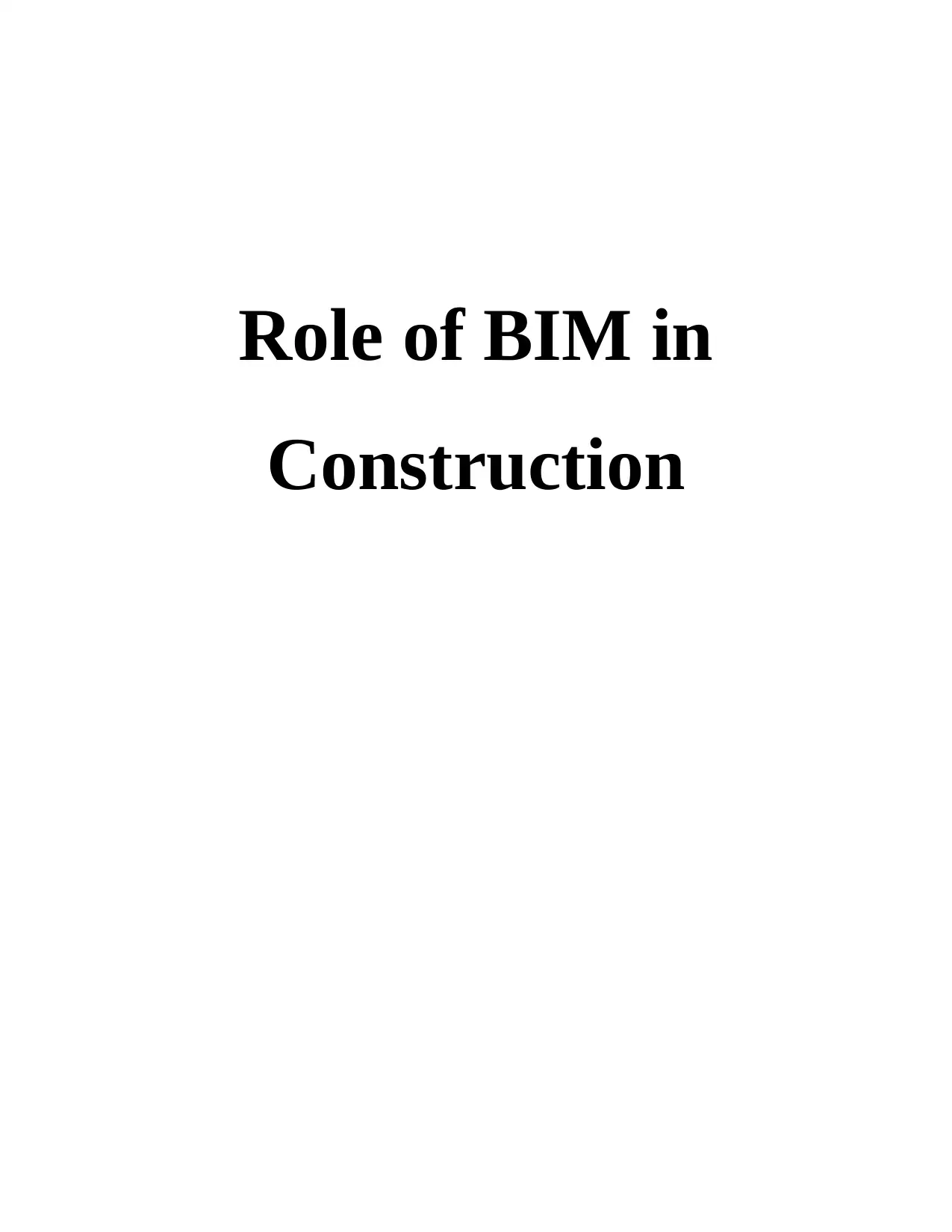
Role of BIM in
Construction
Construction
Paraphrase This Document
Need a fresh take? Get an instant paraphrase of this document with our AI Paraphraser
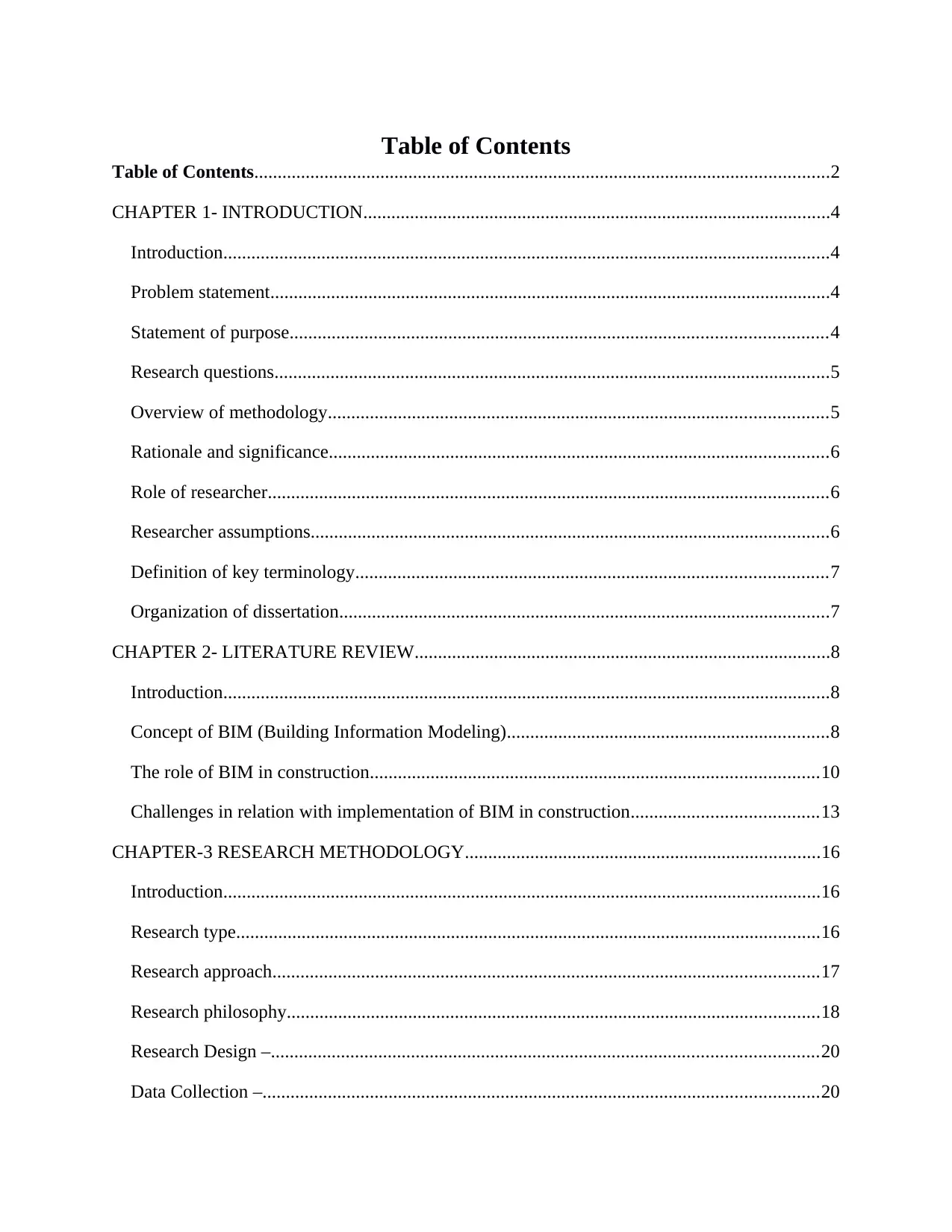
Table of Contents
Table of Contents...........................................................................................................................2
CHAPTER 1- INTRODUCTION....................................................................................................4
Introduction..................................................................................................................................4
Problem statement........................................................................................................................4
Statement of purpose...................................................................................................................4
Research questions.......................................................................................................................5
Overview of methodology...........................................................................................................5
Rationale and significance...........................................................................................................6
Role of researcher........................................................................................................................6
Researcher assumptions...............................................................................................................6
Definition of key terminology.....................................................................................................7
Organization of dissertation.........................................................................................................7
CHAPTER 2- LITERATURE REVIEW.........................................................................................8
Introduction..................................................................................................................................8
Concept of BIM (Building Information Modeling).....................................................................8
The role of BIM in construction................................................................................................10
Challenges in relation with implementation of BIM in construction........................................13
CHAPTER-3 RESEARCH METHODOLOGY............................................................................16
Introduction................................................................................................................................16
Research type.............................................................................................................................16
Research approach.....................................................................................................................17
Research philosophy..................................................................................................................18
Research Design –.....................................................................................................................20
Data Collection –.......................................................................................................................20
Table of Contents...........................................................................................................................2
CHAPTER 1- INTRODUCTION....................................................................................................4
Introduction..................................................................................................................................4
Problem statement........................................................................................................................4
Statement of purpose...................................................................................................................4
Research questions.......................................................................................................................5
Overview of methodology...........................................................................................................5
Rationale and significance...........................................................................................................6
Role of researcher........................................................................................................................6
Researcher assumptions...............................................................................................................6
Definition of key terminology.....................................................................................................7
Organization of dissertation.........................................................................................................7
CHAPTER 2- LITERATURE REVIEW.........................................................................................8
Introduction..................................................................................................................................8
Concept of BIM (Building Information Modeling).....................................................................8
The role of BIM in construction................................................................................................10
Challenges in relation with implementation of BIM in construction........................................13
CHAPTER-3 RESEARCH METHODOLOGY............................................................................16
Introduction................................................................................................................................16
Research type.............................................................................................................................16
Research approach.....................................................................................................................17
Research philosophy..................................................................................................................18
Research Design –.....................................................................................................................20
Data Collection –.......................................................................................................................20
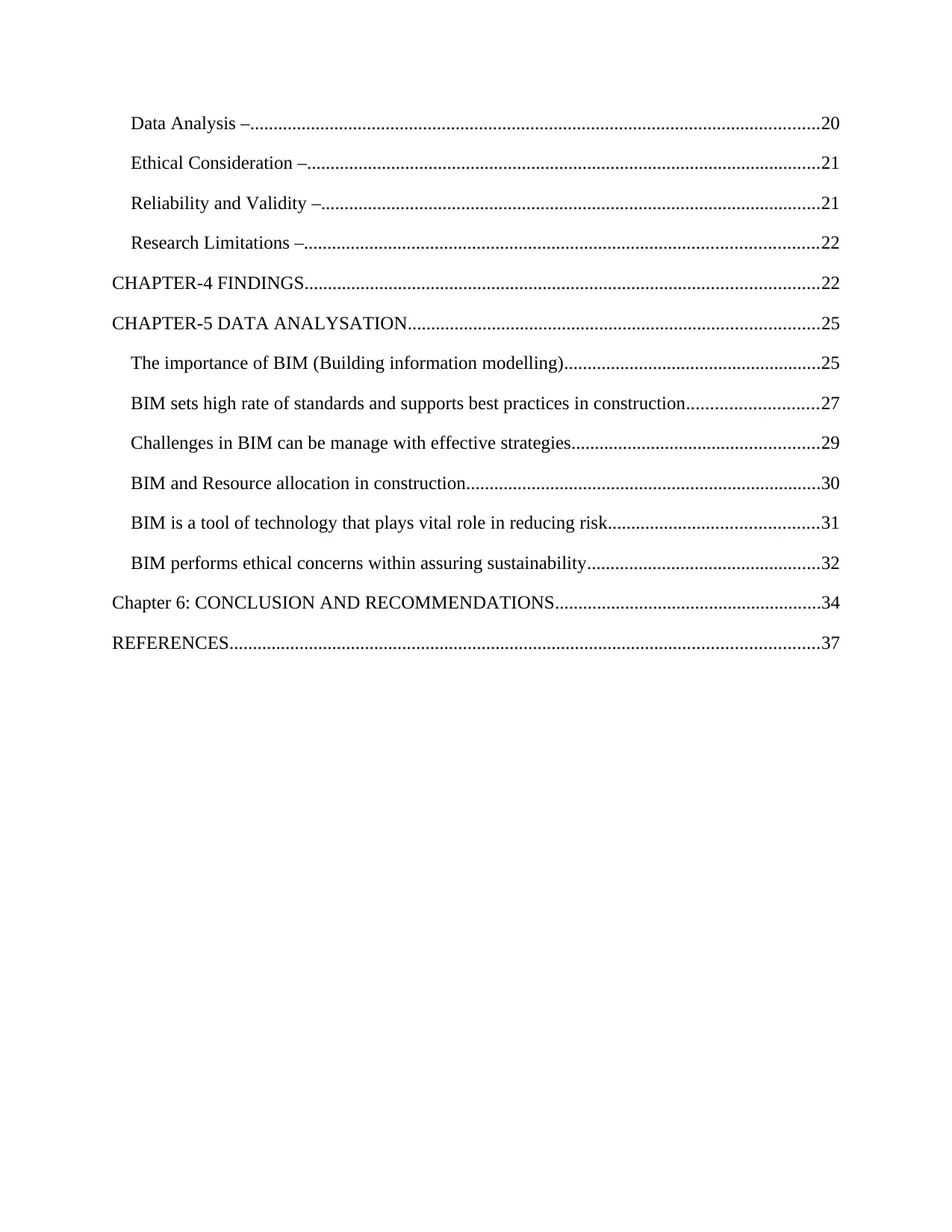
Data Analysis –..........................................................................................................................20
Ethical Consideration –..............................................................................................................21
Reliability and Validity –...........................................................................................................21
Research Limitations –..............................................................................................................22
CHAPTER-4 FINDINGS..............................................................................................................22
CHAPTER-5 DATA ANALYSATION........................................................................................25
The importance of BIM (Building information modelling).......................................................25
BIM sets high rate of standards and supports best practices in construction............................27
Challenges in BIM can be manage with effective strategies.....................................................29
BIM and Resource allocation in construction............................................................................30
BIM is a tool of technology that plays vital role in reducing risk.............................................31
BIM performs ethical concerns within assuring sustainability..................................................32
Chapter 6: CONCLUSION AND RECOMMENDATIONS.........................................................34
REFERENCES..............................................................................................................................37
Ethical Consideration –..............................................................................................................21
Reliability and Validity –...........................................................................................................21
Research Limitations –..............................................................................................................22
CHAPTER-4 FINDINGS..............................................................................................................22
CHAPTER-5 DATA ANALYSATION........................................................................................25
The importance of BIM (Building information modelling).......................................................25
BIM sets high rate of standards and supports best practices in construction............................27
Challenges in BIM can be manage with effective strategies.....................................................29
BIM and Resource allocation in construction............................................................................30
BIM is a tool of technology that plays vital role in reducing risk.............................................31
BIM performs ethical concerns within assuring sustainability..................................................32
Chapter 6: CONCLUSION AND RECOMMENDATIONS.........................................................34
REFERENCES..............................................................................................................................37
⊘ This is a preview!⊘
Do you want full access?
Subscribe today to unlock all pages.

Trusted by 1+ million students worldwide
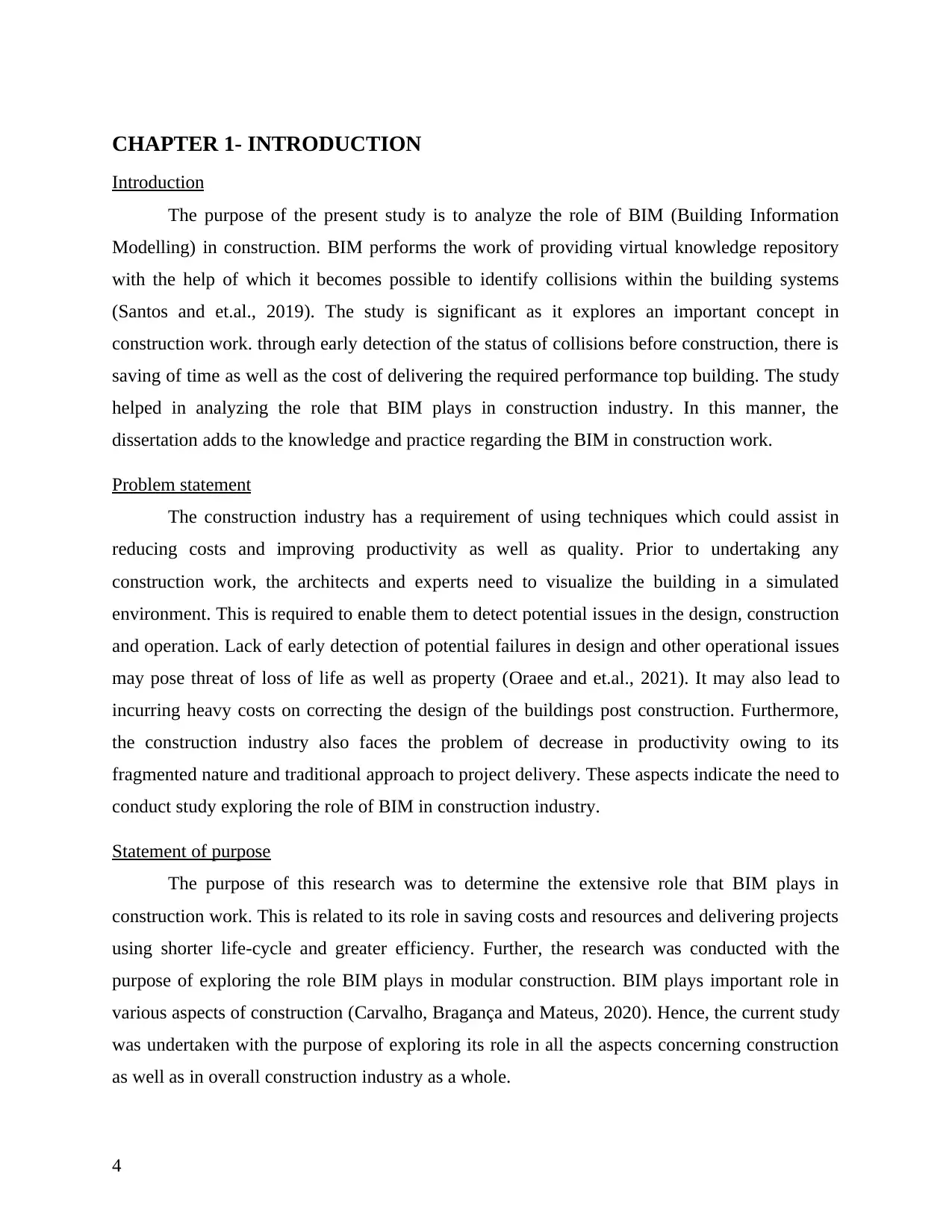
CHAPTER 1- INTRODUCTION
Introduction
The purpose of the present study is to analyze the role of BIM (Building Information
Modelling) in construction. BIM performs the work of providing virtual knowledge repository
with the help of which it becomes possible to identify collisions within the building systems
(Santos and et.al., 2019). The study is significant as it explores an important concept in
construction work. through early detection of the status of collisions before construction, there is
saving of time as well as the cost of delivering the required performance top building. The study
helped in analyzing the role that BIM plays in construction industry. In this manner, the
dissertation adds to the knowledge and practice regarding the BIM in construction work.
Problem statement
The construction industry has a requirement of using techniques which could assist in
reducing costs and improving productivity as well as quality. Prior to undertaking any
construction work, the architects and experts need to visualize the building in a simulated
environment. This is required to enable them to detect potential issues in the design, construction
and operation. Lack of early detection of potential failures in design and other operational issues
may pose threat of loss of life as well as property (Oraee and et.al., 2021). It may also lead to
incurring heavy costs on correcting the design of the buildings post construction. Furthermore,
the construction industry also faces the problem of decrease in productivity owing to its
fragmented nature and traditional approach to project delivery. These aspects indicate the need to
conduct study exploring the role of BIM in construction industry.
Statement of purpose
The purpose of this research was to determine the extensive role that BIM plays in
construction work. This is related to its role in saving costs and resources and delivering projects
using shorter life-cycle and greater efficiency. Further, the research was conducted with the
purpose of exploring the role BIM plays in modular construction. BIM plays important role in
various aspects of construction (Carvalho, Bragança and Mateus, 2020). Hence, the current study
was undertaken with the purpose of exploring its role in all the aspects concerning construction
as well as in overall construction industry as a whole.
4
Introduction
The purpose of the present study is to analyze the role of BIM (Building Information
Modelling) in construction. BIM performs the work of providing virtual knowledge repository
with the help of which it becomes possible to identify collisions within the building systems
(Santos and et.al., 2019). The study is significant as it explores an important concept in
construction work. through early detection of the status of collisions before construction, there is
saving of time as well as the cost of delivering the required performance top building. The study
helped in analyzing the role that BIM plays in construction industry. In this manner, the
dissertation adds to the knowledge and practice regarding the BIM in construction work.
Problem statement
The construction industry has a requirement of using techniques which could assist in
reducing costs and improving productivity as well as quality. Prior to undertaking any
construction work, the architects and experts need to visualize the building in a simulated
environment. This is required to enable them to detect potential issues in the design, construction
and operation. Lack of early detection of potential failures in design and other operational issues
may pose threat of loss of life as well as property (Oraee and et.al., 2021). It may also lead to
incurring heavy costs on correcting the design of the buildings post construction. Furthermore,
the construction industry also faces the problem of decrease in productivity owing to its
fragmented nature and traditional approach to project delivery. These aspects indicate the need to
conduct study exploring the role of BIM in construction industry.
Statement of purpose
The purpose of this research was to determine the extensive role that BIM plays in
construction work. This is related to its role in saving costs and resources and delivering projects
using shorter life-cycle and greater efficiency. Further, the research was conducted with the
purpose of exploring the role BIM plays in modular construction. BIM plays important role in
various aspects of construction (Carvalho, Bragança and Mateus, 2020). Hence, the current study
was undertaken with the purpose of exploring its role in all the aspects concerning construction
as well as in overall construction industry as a whole.
4
Paraphrase This Document
Need a fresh take? Get an instant paraphrase of this document with our AI Paraphraser
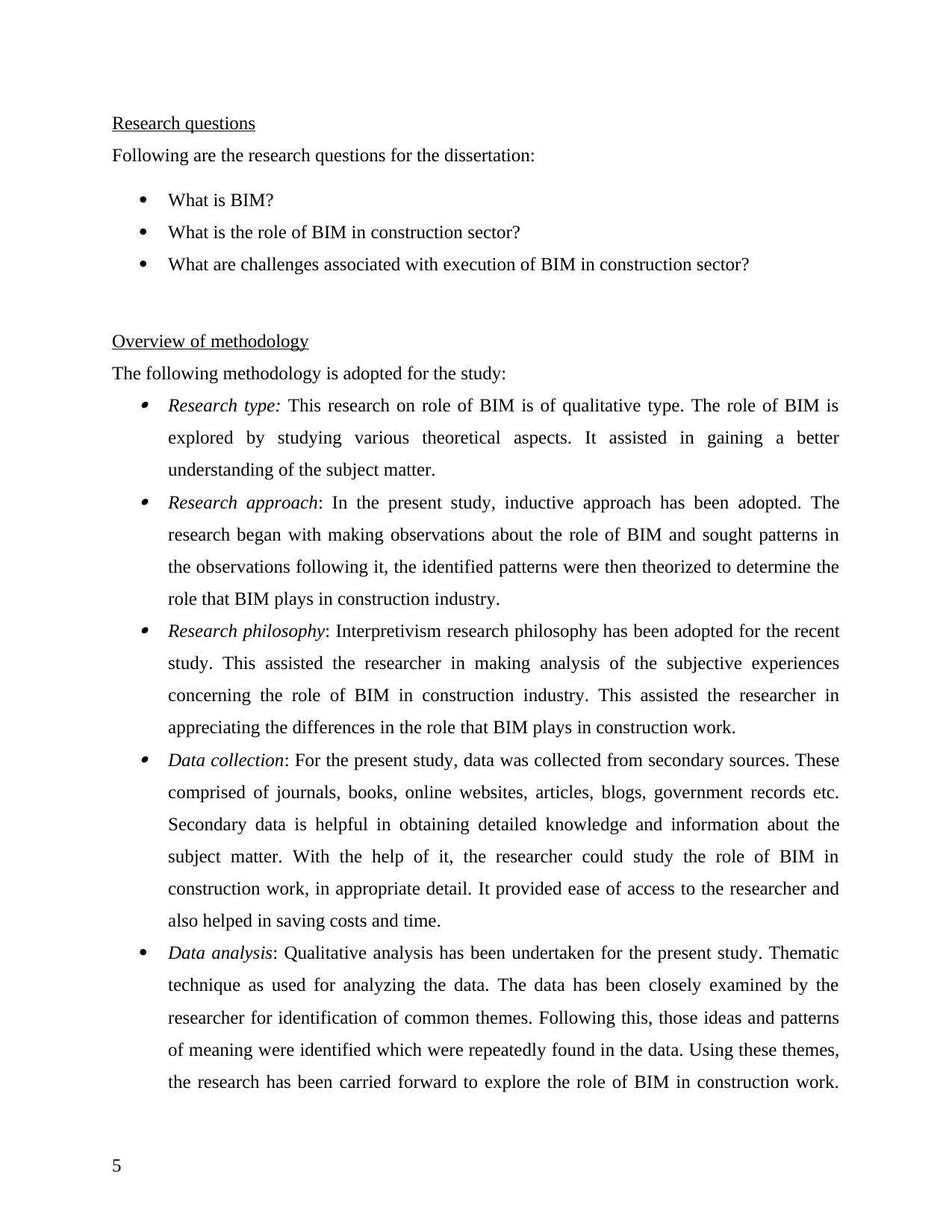
Research questions
Following are the research questions for the dissertation:
What is BIM?
What is the role of BIM in construction sector?
What are challenges associated with execution of BIM in construction sector?
Overview of methodology
The following methodology is adopted for the study: Research type: This research on role of BIM is of qualitative type. The role of BIM is
explored by studying various theoretical aspects. It assisted in gaining a better
understanding of the subject matter. Research approach: In the present study, inductive approach has been adopted. The
research began with making observations about the role of BIM and sought patterns in
the observations following it, the identified patterns were then theorized to determine the
role that BIM plays in construction industry. Research philosophy: Interpretivism research philosophy has been adopted for the recent
study. This assisted the researcher in making analysis of the subjective experiences
concerning the role of BIM in construction industry. This assisted the researcher in
appreciating the differences in the role that BIM plays in construction work. Data collection: For the present study, data was collected from secondary sources. These
comprised of journals, books, online websites, articles, blogs, government records etc.
Secondary data is helpful in obtaining detailed knowledge and information about the
subject matter. With the help of it, the researcher could study the role of BIM in
construction work, in appropriate detail. It provided ease of access to the researcher and
also helped in saving costs and time.
Data analysis: Qualitative analysis has been undertaken for the present study. Thematic
technique as used for analyzing the data. The data has been closely examined by the
researcher for identification of common themes. Following this, those ideas and patterns
of meaning were identified which were repeatedly found in the data. Using these themes,
the research has been carried forward to explore the role of BIM in construction work.
5
Following are the research questions for the dissertation:
What is BIM?
What is the role of BIM in construction sector?
What are challenges associated with execution of BIM in construction sector?
Overview of methodology
The following methodology is adopted for the study: Research type: This research on role of BIM is of qualitative type. The role of BIM is
explored by studying various theoretical aspects. It assisted in gaining a better
understanding of the subject matter. Research approach: In the present study, inductive approach has been adopted. The
research began with making observations about the role of BIM and sought patterns in
the observations following it, the identified patterns were then theorized to determine the
role that BIM plays in construction industry. Research philosophy: Interpretivism research philosophy has been adopted for the recent
study. This assisted the researcher in making analysis of the subjective experiences
concerning the role of BIM in construction industry. This assisted the researcher in
appreciating the differences in the role that BIM plays in construction work. Data collection: For the present study, data was collected from secondary sources. These
comprised of journals, books, online websites, articles, blogs, government records etc.
Secondary data is helpful in obtaining detailed knowledge and information about the
subject matter. With the help of it, the researcher could study the role of BIM in
construction work, in appropriate detail. It provided ease of access to the researcher and
also helped in saving costs and time.
Data analysis: Qualitative analysis has been undertaken for the present study. Thematic
technique as used for analyzing the data. The data has been closely examined by the
researcher for identification of common themes. Following this, those ideas and patterns
of meaning were identified which were repeatedly found in the data. Using these themes,
the research has been carried forward to explore the role of BIM in construction work.
5
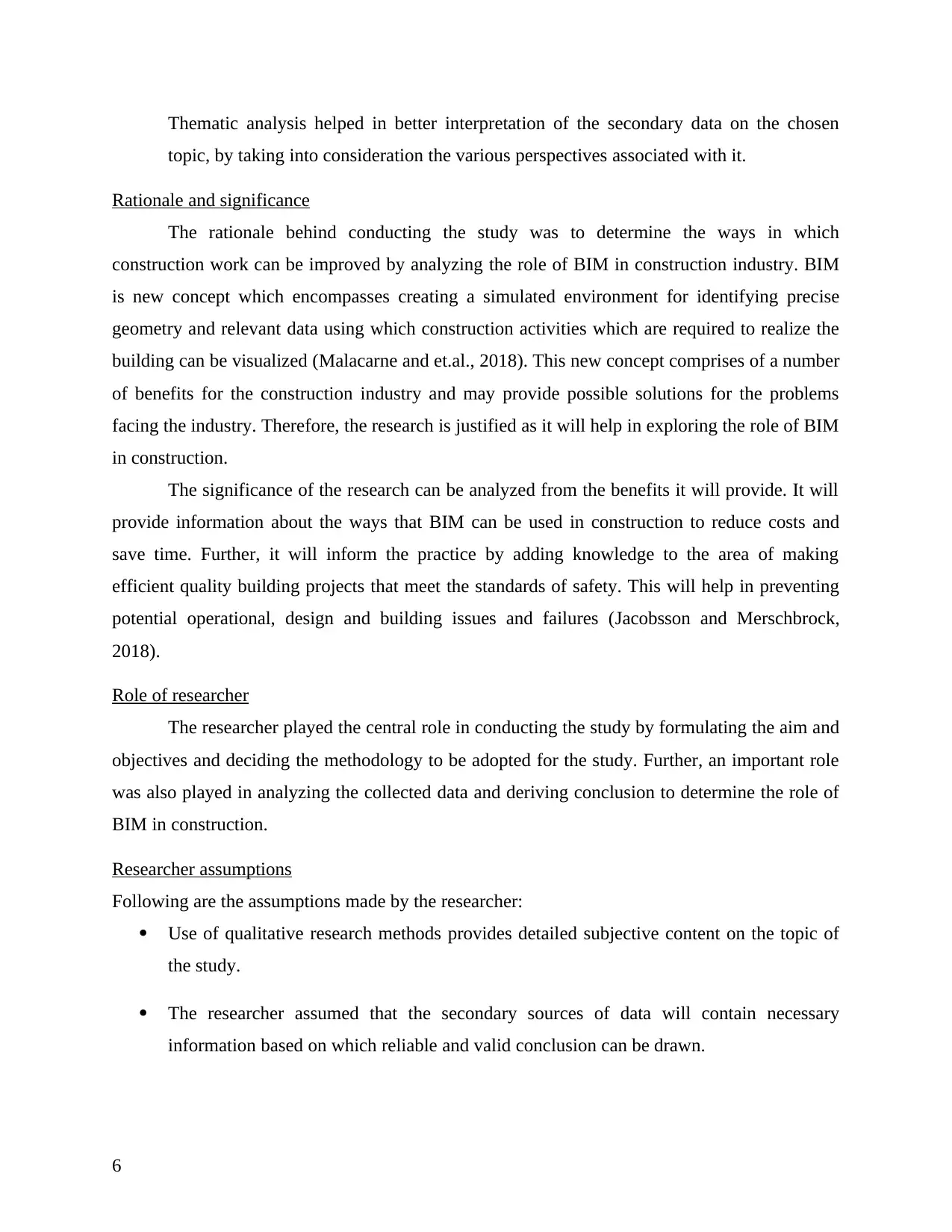
Thematic analysis helped in better interpretation of the secondary data on the chosen
topic, by taking into consideration the various perspectives associated with it.
Rationale and significance
The rationale behind conducting the study was to determine the ways in which
construction work can be improved by analyzing the role of BIM in construction industry. BIM
is new concept which encompasses creating a simulated environment for identifying precise
geometry and relevant data using which construction activities which are required to realize the
building can be visualized (Malacarne and et.al., 2018). This new concept comprises of a number
of benefits for the construction industry and may provide possible solutions for the problems
facing the industry. Therefore, the research is justified as it will help in exploring the role of BIM
in construction.
The significance of the research can be analyzed from the benefits it will provide. It will
provide information about the ways that BIM can be used in construction to reduce costs and
save time. Further, it will inform the practice by adding knowledge to the area of making
efficient quality building projects that meet the standards of safety. This will help in preventing
potential operational, design and building issues and failures (Jacobsson and Merschbrock,
2018).
Role of researcher
The researcher played the central role in conducting the study by formulating the aim and
objectives and deciding the methodology to be adopted for the study. Further, an important role
was also played in analyzing the collected data and deriving conclusion to determine the role of
BIM in construction.
Researcher assumptions
Following are the assumptions made by the researcher:
Use of qualitative research methods provides detailed subjective content on the topic of
the study.
The researcher assumed that the secondary sources of data will contain necessary
information based on which reliable and valid conclusion can be drawn.
6
topic, by taking into consideration the various perspectives associated with it.
Rationale and significance
The rationale behind conducting the study was to determine the ways in which
construction work can be improved by analyzing the role of BIM in construction industry. BIM
is new concept which encompasses creating a simulated environment for identifying precise
geometry and relevant data using which construction activities which are required to realize the
building can be visualized (Malacarne and et.al., 2018). This new concept comprises of a number
of benefits for the construction industry and may provide possible solutions for the problems
facing the industry. Therefore, the research is justified as it will help in exploring the role of BIM
in construction.
The significance of the research can be analyzed from the benefits it will provide. It will
provide information about the ways that BIM can be used in construction to reduce costs and
save time. Further, it will inform the practice by adding knowledge to the area of making
efficient quality building projects that meet the standards of safety. This will help in preventing
potential operational, design and building issues and failures (Jacobsson and Merschbrock,
2018).
Role of researcher
The researcher played the central role in conducting the study by formulating the aim and
objectives and deciding the methodology to be adopted for the study. Further, an important role
was also played in analyzing the collected data and deriving conclusion to determine the role of
BIM in construction.
Researcher assumptions
Following are the assumptions made by the researcher:
Use of qualitative research methods provides detailed subjective content on the topic of
the study.
The researcher assumed that the secondary sources of data will contain necessary
information based on which reliable and valid conclusion can be drawn.
6
⊘ This is a preview!⊘
Do you want full access?
Subscribe today to unlock all pages.

Trusted by 1+ million students worldwide
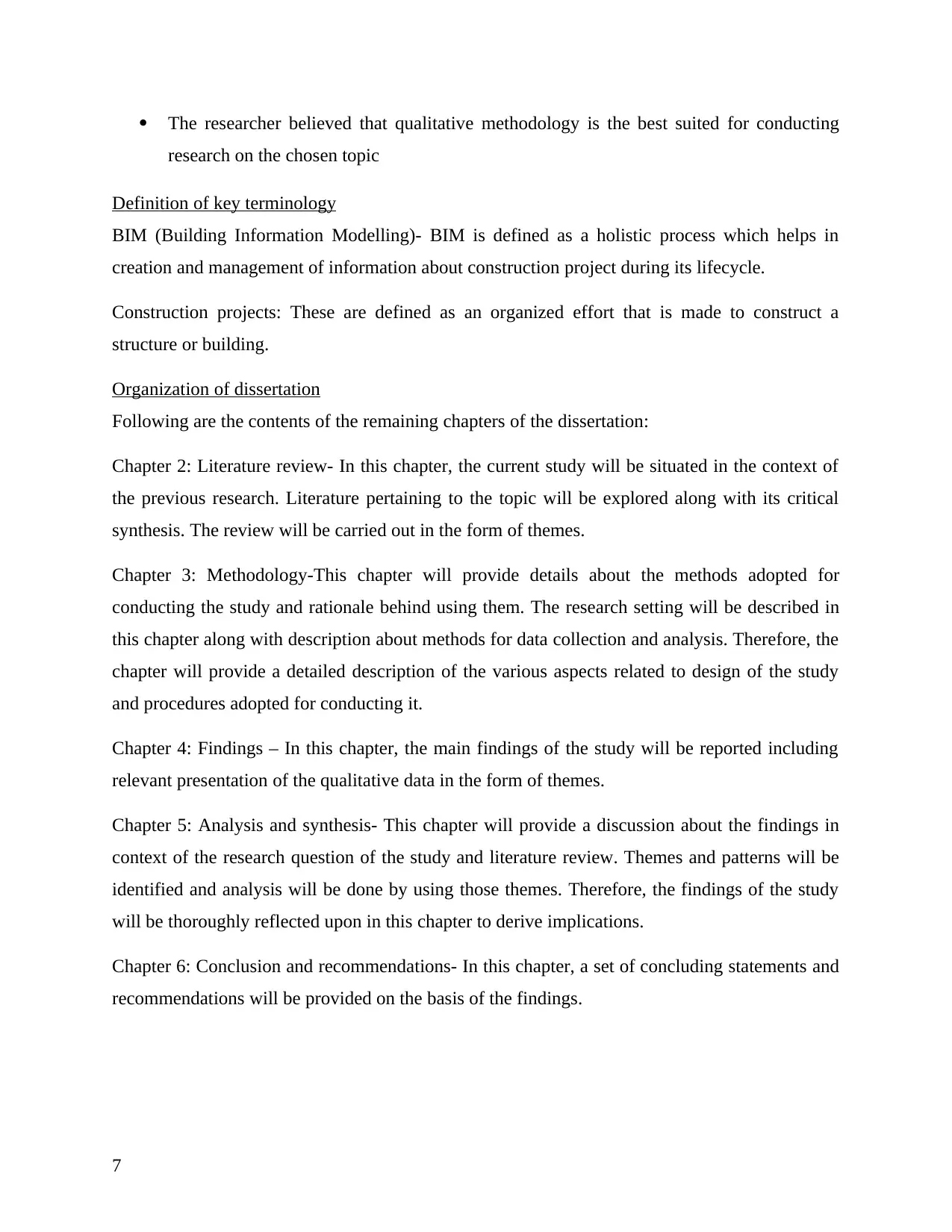
The researcher believed that qualitative methodology is the best suited for conducting
research on the chosen topic
Definition of key terminology
BIM (Building Information Modelling)- BIM is defined as a holistic process which helps in
creation and management of information about construction project during its lifecycle.
Construction projects: These are defined as an organized effort that is made to construct a
structure or building.
Organization of dissertation
Following are the contents of the remaining chapters of the dissertation:
Chapter 2: Literature review- In this chapter, the current study will be situated in the context of
the previous research. Literature pertaining to the topic will be explored along with its critical
synthesis. The review will be carried out in the form of themes.
Chapter 3: Methodology-This chapter will provide details about the methods adopted for
conducting the study and rationale behind using them. The research setting will be described in
this chapter along with description about methods for data collection and analysis. Therefore, the
chapter will provide a detailed description of the various aspects related to design of the study
and procedures adopted for conducting it.
Chapter 4: Findings – In this chapter, the main findings of the study will be reported including
relevant presentation of the qualitative data in the form of themes.
Chapter 5: Analysis and synthesis- This chapter will provide a discussion about the findings in
context of the research question of the study and literature review. Themes and patterns will be
identified and analysis will be done by using those themes. Therefore, the findings of the study
will be thoroughly reflected upon in this chapter to derive implications.
Chapter 6: Conclusion and recommendations- In this chapter, a set of concluding statements and
recommendations will be provided on the basis of the findings.
7
research on the chosen topic
Definition of key terminology
BIM (Building Information Modelling)- BIM is defined as a holistic process which helps in
creation and management of information about construction project during its lifecycle.
Construction projects: These are defined as an organized effort that is made to construct a
structure or building.
Organization of dissertation
Following are the contents of the remaining chapters of the dissertation:
Chapter 2: Literature review- In this chapter, the current study will be situated in the context of
the previous research. Literature pertaining to the topic will be explored along with its critical
synthesis. The review will be carried out in the form of themes.
Chapter 3: Methodology-This chapter will provide details about the methods adopted for
conducting the study and rationale behind using them. The research setting will be described in
this chapter along with description about methods for data collection and analysis. Therefore, the
chapter will provide a detailed description of the various aspects related to design of the study
and procedures adopted for conducting it.
Chapter 4: Findings – In this chapter, the main findings of the study will be reported including
relevant presentation of the qualitative data in the form of themes.
Chapter 5: Analysis and synthesis- This chapter will provide a discussion about the findings in
context of the research question of the study and literature review. Themes and patterns will be
identified and analysis will be done by using those themes. Therefore, the findings of the study
will be thoroughly reflected upon in this chapter to derive implications.
Chapter 6: Conclusion and recommendations- In this chapter, a set of concluding statements and
recommendations will be provided on the basis of the findings.
7
Paraphrase This Document
Need a fresh take? Get an instant paraphrase of this document with our AI Paraphraser
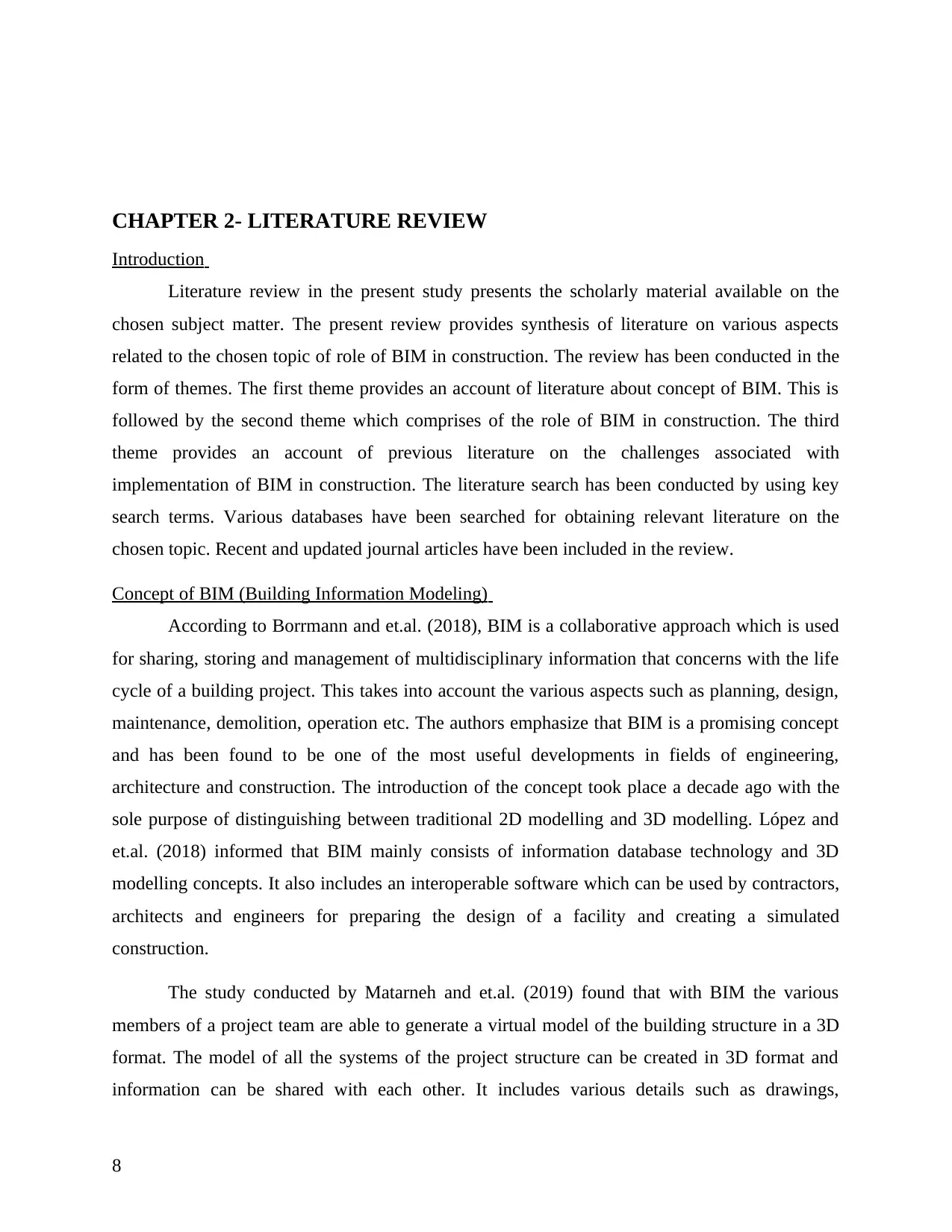
CHAPTER 2- LITERATURE REVIEW
Introduction
Literature review in the present study presents the scholarly material available on the
chosen subject matter. The present review provides synthesis of literature on various aspects
related to the chosen topic of role of BIM in construction. The review has been conducted in the
form of themes. The first theme provides an account of literature about concept of BIM. This is
followed by the second theme which comprises of the role of BIM in construction. The third
theme provides an account of previous literature on the challenges associated with
implementation of BIM in construction. The literature search has been conducted by using key
search terms. Various databases have been searched for obtaining relevant literature on the
chosen topic. Recent and updated journal articles have been included in the review.
Concept of BIM (Building Information Modeling)
According to Borrmann and et.al. (2018), BIM is a collaborative approach which is used
for sharing, storing and management of multidisciplinary information that concerns with the life
cycle of a building project. This takes into account the various aspects such as planning, design,
maintenance, demolition, operation etc. The authors emphasize that BIM is a promising concept
and has been found to be one of the most useful developments in fields of engineering,
architecture and construction. The introduction of the concept took place a decade ago with the
sole purpose of distinguishing between traditional 2D modelling and 3D modelling. López and
et.al. (2018) informed that BIM mainly consists of information database technology and 3D
modelling concepts. It also includes an interoperable software which can be used by contractors,
architects and engineers for preparing the design of a facility and creating a simulated
construction.
The study conducted by Matarneh and et.al. (2019) found that with BIM the various
members of a project team are able to generate a virtual model of the building structure in a 3D
format. The model of all the systems of the project structure can be created in 3D format and
information can be shared with each other. It includes various details such as drawings,
8
Introduction
Literature review in the present study presents the scholarly material available on the
chosen subject matter. The present review provides synthesis of literature on various aspects
related to the chosen topic of role of BIM in construction. The review has been conducted in the
form of themes. The first theme provides an account of literature about concept of BIM. This is
followed by the second theme which comprises of the role of BIM in construction. The third
theme provides an account of previous literature on the challenges associated with
implementation of BIM in construction. The literature search has been conducted by using key
search terms. Various databases have been searched for obtaining relevant literature on the
chosen topic. Recent and updated journal articles have been included in the review.
Concept of BIM (Building Information Modeling)
According to Borrmann and et.al. (2018), BIM is a collaborative approach which is used
for sharing, storing and management of multidisciplinary information that concerns with the life
cycle of a building project. This takes into account the various aspects such as planning, design,
maintenance, demolition, operation etc. The authors emphasize that BIM is a promising concept
and has been found to be one of the most useful developments in fields of engineering,
architecture and construction. The introduction of the concept took place a decade ago with the
sole purpose of distinguishing between traditional 2D modelling and 3D modelling. López and
et.al. (2018) informed that BIM mainly consists of information database technology and 3D
modelling concepts. It also includes an interoperable software which can be used by contractors,
architects and engineers for preparing the design of a facility and creating a simulated
construction.
The study conducted by Matarneh and et.al. (2019) found that with BIM the various
members of a project team are able to generate a virtual model of the building structure in a 3D
format. The model of all the systems of the project structure can be created in 3D format and
information can be shared with each other. It includes various details such as drawings,
8
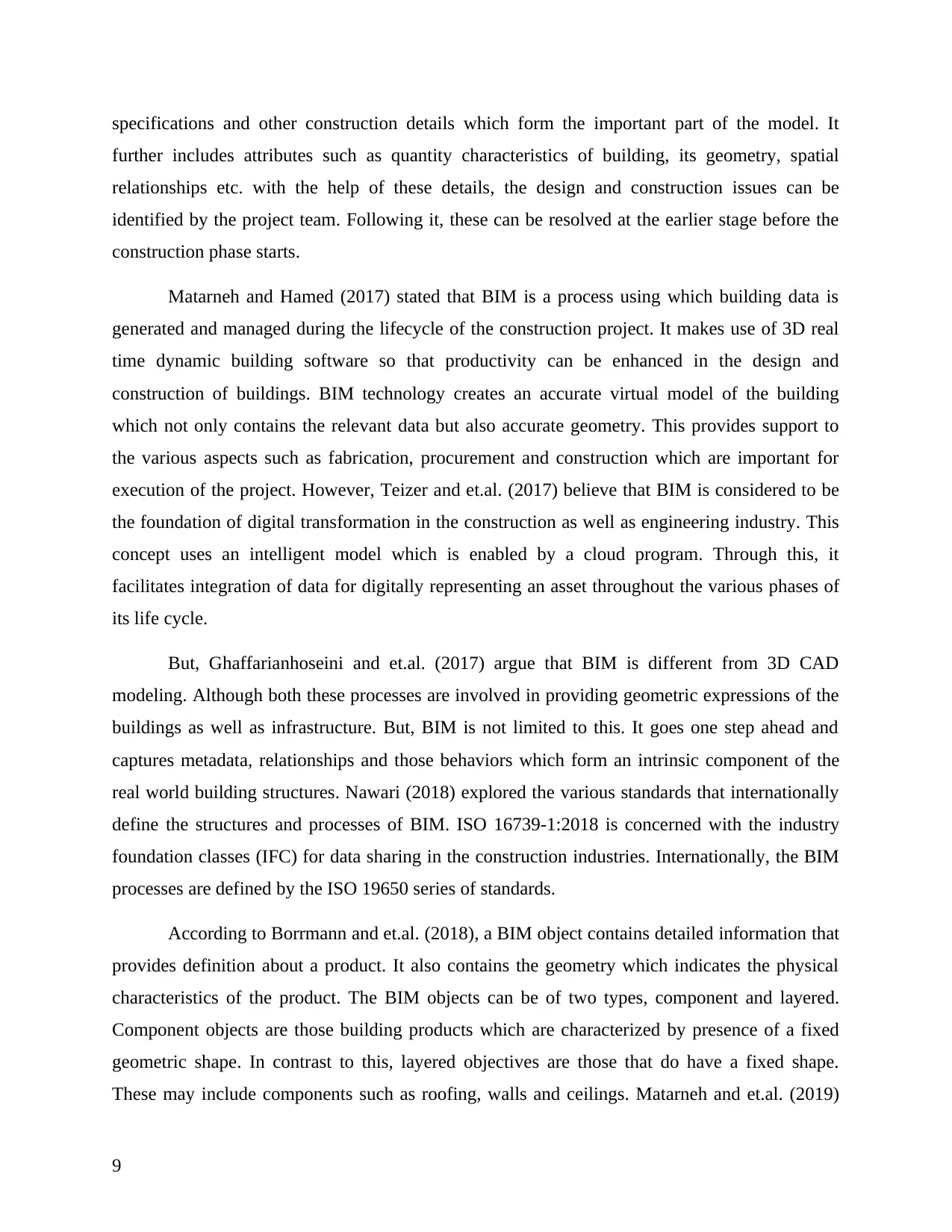
specifications and other construction details which form the important part of the model. It
further includes attributes such as quantity characteristics of building, its geometry, spatial
relationships etc. with the help of these details, the design and construction issues can be
identified by the project team. Following it, these can be resolved at the earlier stage before the
construction phase starts.
Matarneh and Hamed (2017) stated that BIM is a process using which building data is
generated and managed during the lifecycle of the construction project. It makes use of 3D real
time dynamic building software so that productivity can be enhanced in the design and
construction of buildings. BIM technology creates an accurate virtual model of the building
which not only contains the relevant data but also accurate geometry. This provides support to
the various aspects such as fabrication, procurement and construction which are important for
execution of the project. However, Teizer and et.al. (2017) believe that BIM is considered to be
the foundation of digital transformation in the construction as well as engineering industry. This
concept uses an intelligent model which is enabled by a cloud program. Through this, it
facilitates integration of data for digitally representing an asset throughout the various phases of
its life cycle.
But, Ghaffarianhoseini and et.al. (2017) argue that BIM is different from 3D CAD
modeling. Although both these processes are involved in providing geometric expressions of the
buildings as well as infrastructure. But, BIM is not limited to this. It goes one step ahead and
captures metadata, relationships and those behaviors which form an intrinsic component of the
real world building structures. Nawari (2018) explored the various standards that internationally
define the structures and processes of BIM. ISO 16739-1:2018 is concerned with the industry
foundation classes (IFC) for data sharing in the construction industries. Internationally, the BIM
processes are defined by the ISO 19650 series of standards.
According to Borrmann and et.al. (2018), a BIM object contains detailed information that
provides definition about a product. It also contains the geometry which indicates the physical
characteristics of the product. The BIM objects can be of two types, component and layered.
Component objects are those building products which are characterized by presence of a fixed
geometric shape. In contrast to this, layered objectives are those that do have a fixed shape.
These may include components such as roofing, walls and ceilings. Matarneh and et.al. (2019)
9
further includes attributes such as quantity characteristics of building, its geometry, spatial
relationships etc. with the help of these details, the design and construction issues can be
identified by the project team. Following it, these can be resolved at the earlier stage before the
construction phase starts.
Matarneh and Hamed (2017) stated that BIM is a process using which building data is
generated and managed during the lifecycle of the construction project. It makes use of 3D real
time dynamic building software so that productivity can be enhanced in the design and
construction of buildings. BIM technology creates an accurate virtual model of the building
which not only contains the relevant data but also accurate geometry. This provides support to
the various aspects such as fabrication, procurement and construction which are important for
execution of the project. However, Teizer and et.al. (2017) believe that BIM is considered to be
the foundation of digital transformation in the construction as well as engineering industry. This
concept uses an intelligent model which is enabled by a cloud program. Through this, it
facilitates integration of data for digitally representing an asset throughout the various phases of
its life cycle.
But, Ghaffarianhoseini and et.al. (2017) argue that BIM is different from 3D CAD
modeling. Although both these processes are involved in providing geometric expressions of the
buildings as well as infrastructure. But, BIM is not limited to this. It goes one step ahead and
captures metadata, relationships and those behaviors which form an intrinsic component of the
real world building structures. Nawari (2018) explored the various standards that internationally
define the structures and processes of BIM. ISO 16739-1:2018 is concerned with the industry
foundation classes (IFC) for data sharing in the construction industries. Internationally, the BIM
processes are defined by the ISO 19650 series of standards.
According to Borrmann and et.al. (2018), a BIM object contains detailed information that
provides definition about a product. It also contains the geometry which indicates the physical
characteristics of the product. The BIM objects can be of two types, component and layered.
Component objects are those building products which are characterized by presence of a fixed
geometric shape. In contrast to this, layered objectives are those that do have a fixed shape.
These may include components such as roofing, walls and ceilings. Matarneh and et.al. (2019)
9
⊘ This is a preview!⊘
Do you want full access?
Subscribe today to unlock all pages.

Trusted by 1+ million students worldwide
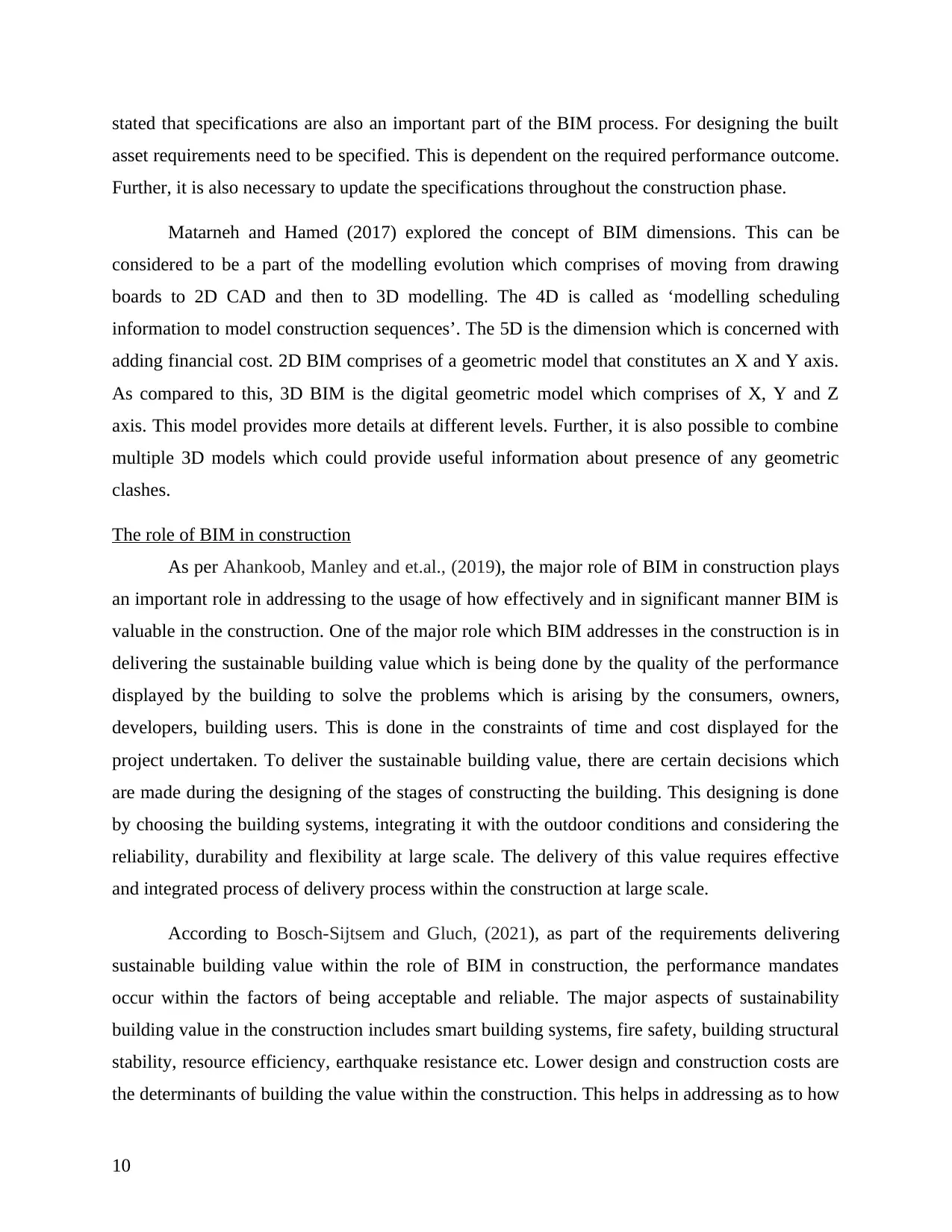
stated that specifications are also an important part of the BIM process. For designing the built
asset requirements need to be specified. This is dependent on the required performance outcome.
Further, it is also necessary to update the specifications throughout the construction phase.
Matarneh and Hamed (2017) explored the concept of BIM dimensions. This can be
considered to be a part of the modelling evolution which comprises of moving from drawing
boards to 2D CAD and then to 3D modelling. The 4D is called as ‘modelling scheduling
information to model construction sequences’. The 5D is the dimension which is concerned with
adding financial cost. 2D BIM comprises of a geometric model that constitutes an X and Y axis.
As compared to this, 3D BIM is the digital geometric model which comprises of X, Y and Z
axis. This model provides more details at different levels. Further, it is also possible to combine
multiple 3D models which could provide useful information about presence of any geometric
clashes.
The role of BIM in construction
As per Ahankoob, Manley and et.al., (2019), the major role of BIM in construction plays
an important role in addressing to the usage of how effectively and in significant manner BIM is
valuable in the construction. One of the major role which BIM addresses in the construction is in
delivering the sustainable building value which is being done by the quality of the performance
displayed by the building to solve the problems which is arising by the consumers, owners,
developers, building users. This is done in the constraints of time and cost displayed for the
project undertaken. To deliver the sustainable building value, there are certain decisions which
are made during the designing of the stages of constructing the building. This designing is done
by choosing the building systems, integrating it with the outdoor conditions and considering the
reliability, durability and flexibility at large scale. The delivery of this value requires effective
and integrated process of delivery process within the construction at large scale.
According to Bosch-Sijtsem and Gluch, (2021), as part of the requirements delivering
sustainable building value within the role of BIM in construction, the performance mandates
occur within the factors of being acceptable and reliable. The major aspects of sustainability
building value in the construction includes smart building systems, fire safety, building structural
stability, resource efficiency, earthquake resistance etc. Lower design and construction costs are
the determinants of building the value within the construction. This helps in addressing as to how
10
asset requirements need to be specified. This is dependent on the required performance outcome.
Further, it is also necessary to update the specifications throughout the construction phase.
Matarneh and Hamed (2017) explored the concept of BIM dimensions. This can be
considered to be a part of the modelling evolution which comprises of moving from drawing
boards to 2D CAD and then to 3D modelling. The 4D is called as ‘modelling scheduling
information to model construction sequences’. The 5D is the dimension which is concerned with
adding financial cost. 2D BIM comprises of a geometric model that constitutes an X and Y axis.
As compared to this, 3D BIM is the digital geometric model which comprises of X, Y and Z
axis. This model provides more details at different levels. Further, it is also possible to combine
multiple 3D models which could provide useful information about presence of any geometric
clashes.
The role of BIM in construction
As per Ahankoob, Manley and et.al., (2019), the major role of BIM in construction plays
an important role in addressing to the usage of how effectively and in significant manner BIM is
valuable in the construction. One of the major role which BIM addresses in the construction is in
delivering the sustainable building value which is being done by the quality of the performance
displayed by the building to solve the problems which is arising by the consumers, owners,
developers, building users. This is done in the constraints of time and cost displayed for the
project undertaken. To deliver the sustainable building value, there are certain decisions which
are made during the designing of the stages of constructing the building. This designing is done
by choosing the building systems, integrating it with the outdoor conditions and considering the
reliability, durability and flexibility at large scale. The delivery of this value requires effective
and integrated process of delivery process within the construction at large scale.
According to Bosch-Sijtsem and Gluch, (2021), as part of the requirements delivering
sustainable building value within the role of BIM in construction, the performance mandates
occur within the factors of being acceptable and reliable. The major aspects of sustainability
building value in the construction includes smart building systems, fire safety, building structural
stability, resource efficiency, earthquake resistance etc. Lower design and construction costs are
the determinants of building the value within the construction. This helps in addressing as to how
10
Paraphrase This Document
Need a fresh take? Get an instant paraphrase of this document with our AI Paraphraser
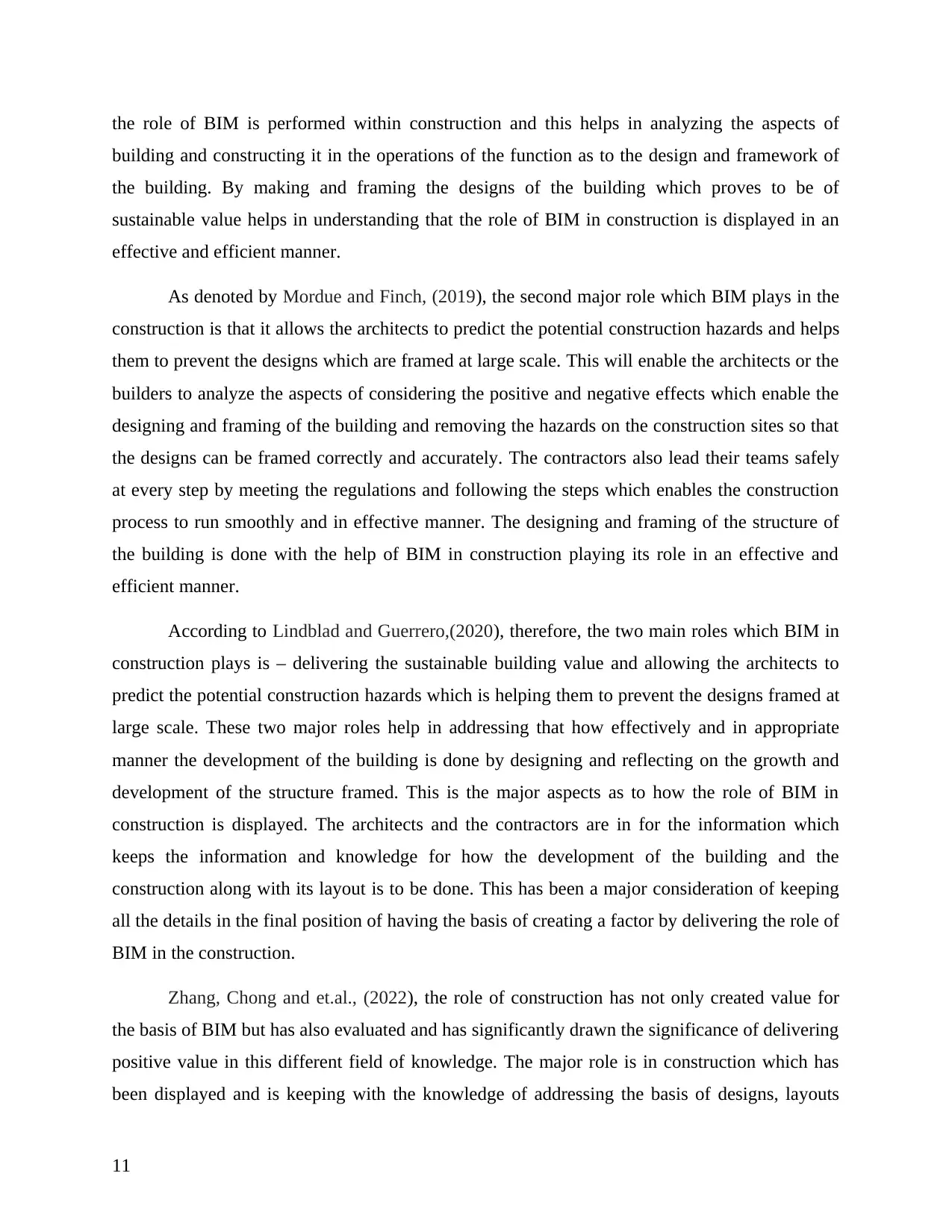
the role of BIM is performed within construction and this helps in analyzing the aspects of
building and constructing it in the operations of the function as to the design and framework of
the building. By making and framing the designs of the building which proves to be of
sustainable value helps in understanding that the role of BIM in construction is displayed in an
effective and efficient manner.
As denoted by Mordue and Finch, (2019), the second major role which BIM plays in the
construction is that it allows the architects to predict the potential construction hazards and helps
them to prevent the designs which are framed at large scale. This will enable the architects or the
builders to analyze the aspects of considering the positive and negative effects which enable the
designing and framing of the building and removing the hazards on the construction sites so that
the designs can be framed correctly and accurately. The contractors also lead their teams safely
at every step by meeting the regulations and following the steps which enables the construction
process to run smoothly and in effective manner. The designing and framing of the structure of
the building is done with the help of BIM in construction playing its role in an effective and
efficient manner.
According to Lindblad and Guerrero,(2020), therefore, the two main roles which BIM in
construction plays is – delivering the sustainable building value and allowing the architects to
predict the potential construction hazards which is helping them to prevent the designs framed at
large scale. These two major roles help in addressing that how effectively and in appropriate
manner the development of the building is done by designing and reflecting on the growth and
development of the structure framed. This is the major aspects as to how the role of BIM in
construction is displayed. The architects and the contractors are in for the information which
keeps the information and knowledge for how the development of the building and the
construction along with its layout is to be done. This has been a major consideration of keeping
all the details in the final position of having the basis of creating a factor by delivering the role of
BIM in the construction.
Zhang, Chong and et.al., (2022), the role of construction has not only created value for
the basis of BIM but has also evaluated and has significantly drawn the significance of delivering
positive value in this different field of knowledge. The major role is in construction which has
been displayed and is keeping with the knowledge of addressing the basis of designs, layouts
11
building and constructing it in the operations of the function as to the design and framework of
the building. By making and framing the designs of the building which proves to be of
sustainable value helps in understanding that the role of BIM in construction is displayed in an
effective and efficient manner.
As denoted by Mordue and Finch, (2019), the second major role which BIM plays in the
construction is that it allows the architects to predict the potential construction hazards and helps
them to prevent the designs which are framed at large scale. This will enable the architects or the
builders to analyze the aspects of considering the positive and negative effects which enable the
designing and framing of the building and removing the hazards on the construction sites so that
the designs can be framed correctly and accurately. The contractors also lead their teams safely
at every step by meeting the regulations and following the steps which enables the construction
process to run smoothly and in effective manner. The designing and framing of the structure of
the building is done with the help of BIM in construction playing its role in an effective and
efficient manner.
According to Lindblad and Guerrero,(2020), therefore, the two main roles which BIM in
construction plays is – delivering the sustainable building value and allowing the architects to
predict the potential construction hazards which is helping them to prevent the designs framed at
large scale. These two major roles help in addressing that how effectively and in appropriate
manner the development of the building is done by designing and reflecting on the growth and
development of the structure framed. This is the major aspects as to how the role of BIM in
construction is displayed. The architects and the contractors are in for the information which
keeps the information and knowledge for how the development of the building and the
construction along with its layout is to be done. This has been a major consideration of keeping
all the details in the final position of having the basis of creating a factor by delivering the role of
BIM in the construction.
Zhang, Chong and et.al., (2022), the role of construction has not only created value for
the basis of BIM but has also evaluated and has significantly drawn the significance of delivering
positive value in this different field of knowledge. The major role is in construction which has
been displayed and is keeping with the knowledge of addressing the basis of designs, layouts
11
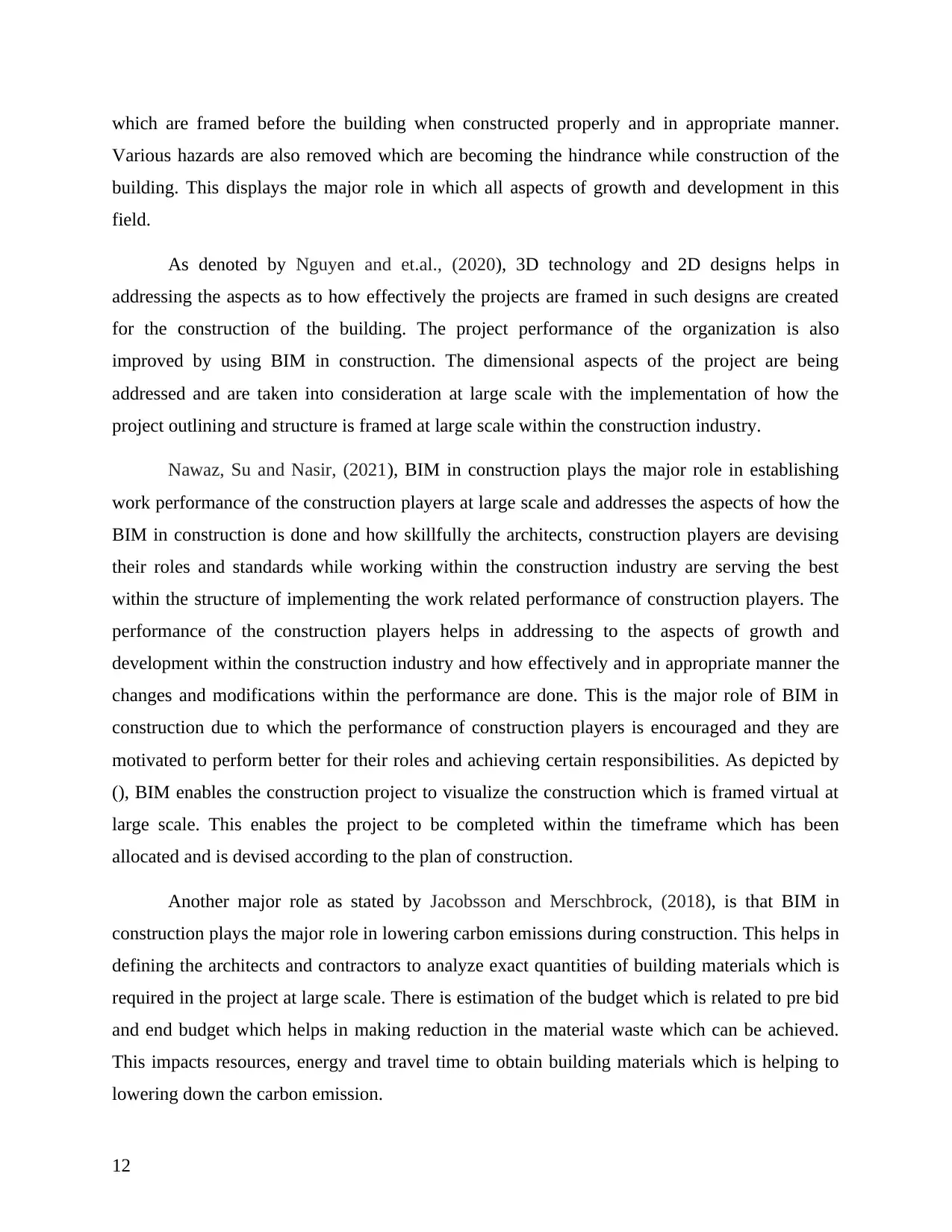
which are framed before the building when constructed properly and in appropriate manner.
Various hazards are also removed which are becoming the hindrance while construction of the
building. This displays the major role in which all aspects of growth and development in this
field.
As denoted by Nguyen and et.al., (2020), 3D technology and 2D designs helps in
addressing the aspects as to how effectively the projects are framed in such designs are created
for the construction of the building. The project performance of the organization is also
improved by using BIM in construction. The dimensional aspects of the project are being
addressed and are taken into consideration at large scale with the implementation of how the
project outlining and structure is framed at large scale within the construction industry.
Nawaz, Su and Nasir, (2021), BIM in construction plays the major role in establishing
work performance of the construction players at large scale and addresses the aspects of how the
BIM in construction is done and how skillfully the architects, construction players are devising
their roles and standards while working within the construction industry are serving the best
within the structure of implementing the work related performance of construction players. The
performance of the construction players helps in addressing to the aspects of growth and
development within the construction industry and how effectively and in appropriate manner the
changes and modifications within the performance are done. This is the major role of BIM in
construction due to which the performance of construction players is encouraged and they are
motivated to perform better for their roles and achieving certain responsibilities. As depicted by
(), BIM enables the construction project to visualize the construction which is framed virtual at
large scale. This enables the project to be completed within the timeframe which has been
allocated and is devised according to the plan of construction.
Another major role as stated by Jacobsson and Merschbrock, (2018), is that BIM in
construction plays the major role in lowering carbon emissions during construction. This helps in
defining the architects and contractors to analyze exact quantities of building materials which is
required in the project at large scale. There is estimation of the budget which is related to pre bid
and end budget which helps in making reduction in the material waste which can be achieved.
This impacts resources, energy and travel time to obtain building materials which is helping to
lowering down the carbon emission.
12
Various hazards are also removed which are becoming the hindrance while construction of the
building. This displays the major role in which all aspects of growth and development in this
field.
As denoted by Nguyen and et.al., (2020), 3D technology and 2D designs helps in
addressing the aspects as to how effectively the projects are framed in such designs are created
for the construction of the building. The project performance of the organization is also
improved by using BIM in construction. The dimensional aspects of the project are being
addressed and are taken into consideration at large scale with the implementation of how the
project outlining and structure is framed at large scale within the construction industry.
Nawaz, Su and Nasir, (2021), BIM in construction plays the major role in establishing
work performance of the construction players at large scale and addresses the aspects of how the
BIM in construction is done and how skillfully the architects, construction players are devising
their roles and standards while working within the construction industry are serving the best
within the structure of implementing the work related performance of construction players. The
performance of the construction players helps in addressing to the aspects of growth and
development within the construction industry and how effectively and in appropriate manner the
changes and modifications within the performance are done. This is the major role of BIM in
construction due to which the performance of construction players is encouraged and they are
motivated to perform better for their roles and achieving certain responsibilities. As depicted by
(), BIM enables the construction project to visualize the construction which is framed virtual at
large scale. This enables the project to be completed within the timeframe which has been
allocated and is devised according to the plan of construction.
Another major role as stated by Jacobsson and Merschbrock, (2018), is that BIM in
construction plays the major role in lowering carbon emissions during construction. This helps in
defining the architects and contractors to analyze exact quantities of building materials which is
required in the project at large scale. There is estimation of the budget which is related to pre bid
and end budget which helps in making reduction in the material waste which can be achieved.
This impacts resources, energy and travel time to obtain building materials which is helping to
lowering down the carbon emission.
12
⊘ This is a preview!⊘
Do you want full access?
Subscribe today to unlock all pages.

Trusted by 1+ million students worldwide
1 out of 41
Related Documents
Your All-in-One AI-Powered Toolkit for Academic Success.
+13062052269
info@desklib.com
Available 24*7 on WhatsApp / Email
![[object Object]](/_next/static/media/star-bottom.7253800d.svg)
Unlock your academic potential
Copyright © 2020–2025 A2Z Services. All Rights Reserved. Developed and managed by ZUCOL.





